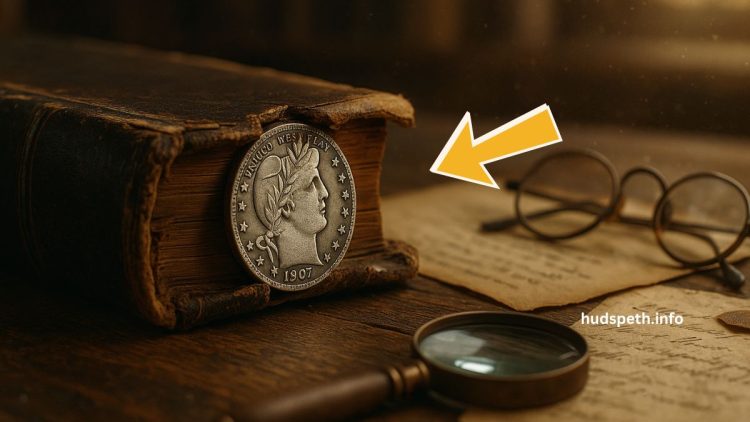In an extraordinary turn of events, a rare 1907 Barber Quarter was discovered concealed within the spine of an old book, leading to a record-breaking auction sale of $80,000. This remarkable find has captivated numismatists and collectors worldwide, highlighting the enduring allure of rare coins and the unexpected places they can be found.
The Barber Quarter: A Brief Overview
The Barber Quarter, minted from 1892 to 1916, was designed by Charles E. Barber, the Chief Engraver of the U.S. Mint. Featuring the Liberty Head on the obverse and a heraldic eagle on the reverse, the coin was produced in Philadelphia, Denver, New Orleans, and San Francisco mints. The 1907 issue, in particular, holds significant interest due to its age and the historical context of its production.
Discovery of the Hidden Coin
The coin’s discovery occurred during the cataloging of a private library, where an archivist noticed an unusual bulge in the spine of a vintage book. Upon investigation, the hidden compartment revealed a 1907 Barber Quarter in exceptional condition. The coin’s preservation, shielded from environmental factors for over a century, contributed to its remarkable state.
Auction Details and Record Sale
Recognizing the coin’s potential value, the owner consigned it to a reputable auction house. The coin underwent professional grading and was certified as MS-67 by the Professional Coin Grading Service (PCGS). The auction attracted significant attention, culminating in a final sale price of $80,000, setting a new record for a 1907 Barber Quarter.
Factors Influencing the Coin’s Value
Several elements contributed to the coin’s impressive auction result:
- Grade: The coin’s MS-67 grade indicates a near-perfect state, with minimal imperfections and full luster.
- Rarity: High-grade examples of the 1907 Barber Quarter are scarce, increasing demand among collectors.
- Historical Significance: The coin’s age and the unique story of its discovery added to its allure.
- Market Demand: The numismatic market has seen increased interest in rare and high-grade coins, driving prices upward.
Comparative Value
To contextualize the coin’s value, consider the following table outlining typical values for 1907 Barber Quarters based on condition:
| Grade | Estimated Value |
|---|---|
| Good (G-4) | $10 – $15 |
| Fine (F-12) | $25 – $35 |
| Extremely Fine (EF-40) | $65 – $80 |
| About Uncirculated (AU-50) | $120 – $150 |
| Mint State (MS-60) | $200 – $300 |
| Mint State (MS-65) | $1,000 – $1,500 |
| Mint State (MS-67) | Up to $80,000 |
Note: Values are approximate and can vary based on market conditions.
Significance of the Find
This discovery underscores the importance of careful examination of antiques and heirlooms. Coins, often hidden or forgotten, can hold substantial value. The story also highlights the role of professional grading in authenticating and assessing a coin’s worth, which is crucial for achieving optimal auction results
The hidden 1907 Barber Quarter serves as a testament to the enduring fascination with numismatics and the potential treasures awaiting discovery. Its journey from obscurity within a book spine to a record-breaking auction sale exemplifies the excitement and rewards of coin collecting.
Collectors and enthusiasts are reminded of the value that can lie hidden in the most unexpected places.
FAQs
What makes the 1907 Barber Quarter valuable?
Its value stems from its high grade (MS-67), rarity in such condition, historical significance, and the unique story of its discovery.
How can I determine the value of a coin I own?
Consult a professional grading service like PCGS or NGC for authentication and grading, which are essential for accurate valuation.
Where can I sell a rare coin?
Rare coins can be sold through reputable auction houses, coin dealers, or online platforms specializing in numismatics. Ensure the platform has a good reputation and offers proper authentication services.

